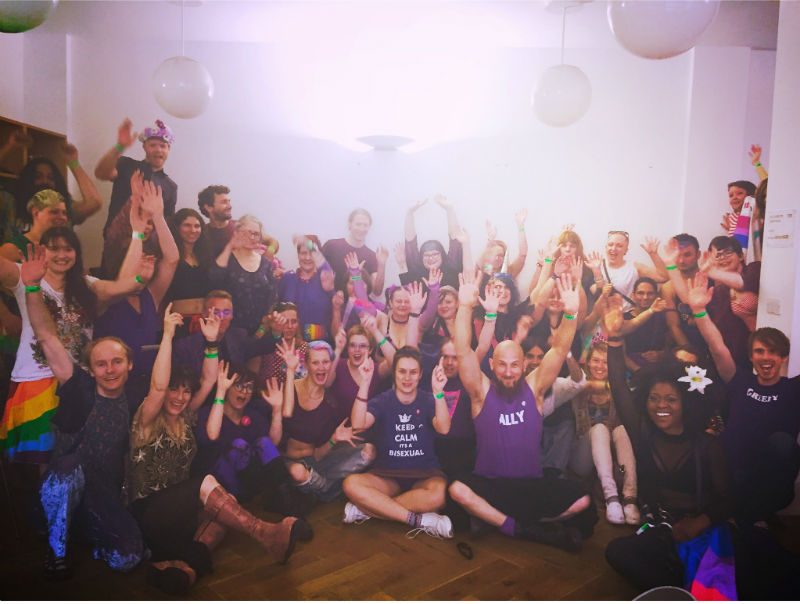Being bisexual at Pride can be a difficult experience, especially if you’re doing it visibly.
Enjoying a PDA (public display of affection) with an opposite-sex partner or marching under a bi banner are both still fairly controversial acts. And even if you’re quiet about it and nobody detects your inner purple flag, the event’s loud “gay” and “lesbian” default vernacular can be a real kick in the stomach. “Do I,” you are sometimes inclined to wonder, “actually belong here?” Personally, I’ve never dared kiss a man/male-spectrum person at Pride. Sad to say, it wouldn’t even cross my mind, because I know what backlash might ensue… beyond what I experience by just standing under a bisexual flag.
Last year, some open-minded souls saw fit to repeatedly screech “BREEDERS!” at our bi contingent on the Pride London parade. A friend in the US says she had “Just be gay!” shouted at her while she marched under a bi Pride flag this year. She’s #StillBisexual… and I’m not only still bi, too, but also reeling from a protracted period of trying and failing to conceive with my recently-ex partner. Not a very good “breeder”, then. Do these people actually realize what they’re saying?
At this year’s Pride in London, my amazing colleague at Biscuit organised a special “bisexual breakfast”. Over a small Buck’s Fizz, a croissant and a beautiful bi flag-coloured My Little Pony toy given to me by a Biscuit fan (aw), I asked Libby what inspired her to run the event. “I was in charge of a bi stall at Pride once when someone came up and told me she didn’t believe in bisexuality,” Libby answers dryly. “She was wearing a t-shirt that said ‘Don’t tell me who I can love’.”
“When I divorced my first husband in 1993, I spent the summer going to Prides on the East Coast of the US – Hartford, Connecticut, Boston, New York City and Washington D.C,” bisexual poet Jan Steckel says. “In Hartford I heard the comic Kate Clinton perform. In NYC I fell down at the feet of the goddess in the form of RuPaul. In D.C. I marched with the Lesbian Avengers and met a woman who would become my girlfriend on the train home. Since moving home to California, I’ve marched in the bisexual contingent at San Francisco Pride with my bi husband Hew Wolff for 18 years.” Have they ever had any problems at Pride? “There’s a somewhat biphobic TV host here who almost always makes some stupid crack about us when we pass,” she responds. “But we’re slowly educating them.”
“I’ve been to Prides with two former cis-male/bisexual partners,” says fellow bi author Crysta Corbyn. “My first partner and I were both wearing bi pride shirts. His said ‘Oh bi goodness’ and mine said ‘I’m not straight and neither is my boyfriend’ – both in pink, purple, and blue lettering. I think bi pride was a new thing to a lot of people, and we were asked a lot of questions about our shirts and our relationship. I was quite butch at the time and he was femme, so we raised some eyebrows. We were openly affectionate with each other.”
But is there an argument for keeping Pride as (at least loosely) a celebration of same-sex love? Does inviting “shades of grey” in allow for it to be turned further into a party/capitalist event that straight people have the potential to monopolise? “I have no problem with bi people,” says Jenny, an annual attendee at NYC Pride. “But I do think that kissing someone of the opposite sex at Pride completely defeats the object. I get so mad when people come into our territory. How am I meant to know if they’re straight or bi? Some people really do just come for the party.” I ask Jenny if she knows who I’m referring to when I talk about the “Mother of Pride” (Brenda Howard), who was instrumental in setting the whole thing up in the first place. Jane has never heard of Howard. Howard was bisexual.
